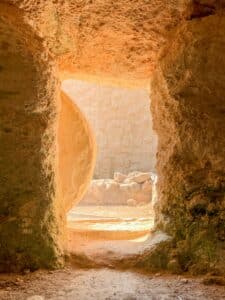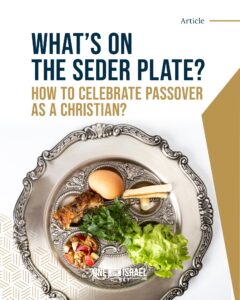With all the accusations of paganism, you might reasonably ask, did eggs ever really symbolize the resurrection of Yeshua the Messiah? Or were they just a syncretistic addition as pagan traditions of various countries, symbols of springtime fertility, incorporated as the Gospel spread? The raging debate about the virtues and vices of easter eggs goes on, but even more than that, how did eggs end up as part of the Passover celebration?
“Why is there an egg on the seder plate?” A family member asked this Passover. “To represent the destruction of the temple,” came the answer. That is what we are told about the burnt egg that has become part of Passover tradition. The burned part is easy to understand, but why an egg? What does an egg symbolize exactly? No one seems to really know.
But if we dig a little into the history of the early church, there are some exciting nuggets to find. Easter eggs, if you will.
How eggs first became involved in the story of Yeshua
 The most basic reason eggs symbolize this season is due to the early tradition among the disciples to fast in the run up to the resurrection, during which eggs would be off limits. However, come Resurrection Day, it was time to crack open the eggs!
The most basic reason eggs symbolize this season is due to the early tradition among the disciples to fast in the run up to the resurrection, during which eggs would be off limits. However, come Resurrection Day, it was time to crack open the eggs!
Today this practice has become known as “Lent” but way back before Easter existed and the first Jewish believers were still figuring out how to mark the Weekend that Changed the World, it had become part of common practice to fast, just as Jesus had done and taught, in the days and weeks preceding the glorious day of His victory. There were differences of opinion about how and when to do it, and for how long, but in the first couple of centuries it had become standard practice for new believers to fast and spend time in contemplation before getting baptized (an originally Jewish tradition) on Resurrection Day.
Way back in the second century, a church leader named Iraneus from Smyrna, who had learned from Polycarp, a direct disciple of the Apostle John, wrote that his “predecessors” in the faith were also fasting before Passover:
“For the controversy is not only about the day, but also about the very manner of the fast; for some think that they ought to fast one day, others two, others even more; and in the opinion of others, the ‘day’ amounts to forty hours, day and night. And such variation of observance did not begin in our own time, but much earlier, in the days of our predecessors who, it would appear, disregarding strictness maintained a practice which is simple and yet allows for personal preference, establishing it for the future, and none the less all these lived in peace, and we also live in peace with one another and the disagreement in the fast confirms our agreement in the faith.” (Irenaeus, Letter to Victor, Historia Ecclesiastica, 5.24.12–13)
 A believer who lived in Caesarea in the fourth century named Eusebius compiled the history of what had happened in the first centuries after Yeshua. He explained some of the wrestling with dates and decisions about how to mark what he called “The Savior’s Pascha”, Pascha being the Greek word for Passover:
A believer who lived in Caesarea in the fourth century named Eusebius compiled the history of what had happened in the first centuries after Yeshua. He explained some of the wrestling with dates and decisions about how to mark what he called “The Savior’s Pascha”, Pascha being the Greek word for Passover:
“No small controversy arose because all the communities of Asia thought it right, as though by a more ancient tradition to observe for the feast of the Saviour’s Pascha the fourteenth day of the moon, on which the Jews had been commanded to kill the lamb. Thus it was necessary to finish the fast on that day, whatever day of the week it might be. … [Yet such was not the custom] in the churches throughout the rest of the world, for from apostolic tradition they kept the custom which still exists that it is not right to finish the fast on any day save that of the resurrection of our Saviour.”
He continued, “… many meetings and conferences of bishops [were held about this, and] all unanimously formulated in their letters the ecclesiastical teaching for those of the faithful everywhere that the mystery of the Lord’s resurrection from the dead could be celebrated on no day save Sunday, and that on that day alone we should celebrate the end of the paschal fast.” (Eusebius, Historia Ecclesiastica, 5.23.1-4)
So you can see that at the beginning there was much wrangling about dates and practices, but the tradition of fasting and celebrating together (with eggs back on the menu) on Resurrection Sunday was well established by the fourth century.
The Greek name for Lent (τεσσαρακοστή=fortieth) is connected to the word for 40, and initially represented 40 hours rather than 40 days since tradition held that there were 40 hours between the death and resurrection of Yeshua. It’s likely the 40 day fast was derived from the time Yeshua Himself fasted for 40 days in the desert. This practice had been established by the time of the Nicean Council in 325, as Lent is mentioned there with the assumption that everyone knows what it is.
So that’s how eggs first became associated with Yeshua’s victory, and came to symbolize the resurrection. But there’s more.
The symbolism of eggs in the Orthodox Pascha tradition
The Orthodox Church still calls the celebration of Resurrection “Pascha”, and the Orthodox Church of America explain the what eggs have come to symbolize for them:
“St. Mary Magdalene, shortly after the resurrection, traveled to Rome and presented the Emperor with a red egg while exclaiming “Christ is risen”—no doubt the association of eggs with Pascha is derived from the fact that during the Great Fast the faithful refrain from eating meat, eggs, dairy products, fish, wine, and oil. Hence, these foods are eaten on Pascha to “break the Fast.””

Today it is tradition, especially in Greek Orthodox churches, to dye eggs red, then play a game where they are broken to symbolize the breaking open of the tomb. There are also other elaborate legends involving Mary Magdalene and her basket of eggs which may or may not be true. Who knows with these things. But I’ll tell you anyway, and you can see what you think. Here’s an explanation (eggsplanation) about why the eggs are dyed red:
“The choice of red — the color of life and victory — bears a long history and dates to ancient Mesopotamia, where early Christians stained eggs red in memory of the blood of Jesus, who was crucified for the salvation of all mankind. The reason the Greek Orthodox Church adopted the custom is still disputed and many sources indicate different reasons.
“The most renowned story links Mary Magdalene to the red Easter eggs custom, who being the first to have seen the empty tomb of Jesus after his resurrection, went to the Roman emperor to inform him of the miracle. The emperor, however, didn’t believe what he was told and announced that he would believe the claims of Mary Magdalene only if the eggs in a basket next to him would turn red instantly, which they did.“1
Perhaps these stories might have been based on a real event and embellished, it’s hard to know. But yes, eggs are well and truly symbollic of the resurrection and have been since the time of the early church.
What do eggs symbolize on the seder plate?
So now back to the question of the Passover seder and the mystery egg. The burnt bit, as we said, makes sense. The destruction of the temple in 70 AD was a historic horror for the Jewish people, and it seems reasonable that a reminder of the key event would make its way onto the Passover table. The choice of an egg to symbolize the destruction, however, is a bit bewildering. Perhaps there are other eggsplanations.
Joseph Tabory, Israel Yuval, Lawrence Hoffman, and the father-son team of Shmuel and Ze’ev Safrai, are all scholars digging into the historical sources concerning the Passover seder. They all agree that the earliest sources for the traditions as we know them today are dated back only to the second temple period, around the time of Yeshua. Indeed, in his work on the subject, Professor Israel J. Yuval of Hebrew University has indicated that the current passover seder tradition includes many ceremonies and stages that have been adopted from the ancient Jewish disciples of Yeshua, the messianic Jews of old.2
 What a shocking thing to suggest! But less shocking when we realize that the earliest mention of the seder meal in Jewish literature is found in the New Testament! Yes, that’s right, the Last Supper, as described in Luke 22, is the earliest documented Passover meal since the time of the Hebrew Scriptures. Scholars such as Professor Yuval are noting3 that many traditions that have been added make more sense with the explanation that the items were introduced to commemorate the death and resurrection of Yeshua.
What a shocking thing to suggest! But less shocking when we realize that the earliest mention of the seder meal in Jewish literature is found in the New Testament! Yes, that’s right, the Last Supper, as described in Luke 22, is the earliest documented Passover meal since the time of the Hebrew Scriptures. Scholars such as Professor Yuval are noting3 that many traditions that have been added make more sense with the explanation that the items were introduced to commemorate the death and resurrection of Yeshua.
Consider the tradition of the Afikomen, for example. Afikomen is a Greek word meaning “afters”. The fact that it’s Greek shows that it was developed during the time when Jews spoke Greek in Israel. Three matzo breads are taken and placed inside a cloth, one is removed, broken in half, and half is hidden while the other is returned. Later there’s a hunt for the hidden matzo which is then broken into pieces and shared around the table with the third cup of “peace”.
Then He took the cup, and gave thanks, and said, “Take this and divide it among yourselves; for I say to you, I will not drink of the fruit of the vine until the kingdom of God comes.”
And He took bread, gave thanks and broke it, and gave it to them, saying, “This is My body which is given for you; do this in remembrance of Me.” (Luke 22:17-19)
The Passover seder is a powerful witness to the redemption purchased by the Messiah and the freedom He has delivered us into. Today’s Passover “Haggadah” (order of service) has since been developed by the Rabbis to try and erase Jesus from the picture, as the video explains below, but the whole ceremony shouts about the link between the Exodus from Egypt and Yeshua, our Passover Lamb who takes away the sin of the world.
Given the fact that many of our current Passover traditions actually started with believers, is it not possible that the egg on the Passover table itself originally symbolized the resurrection?
Happy Resurrection Day!
- https://greekmamachef.gr/en/holy-thursday-dying-eggs-red-story-behind-greek-orthodox-tradition/
- https://prchiz.pl/storage/app/media/2020/03/yuval/2020-03-26-israel-jacob-yuval-let-us-recite-before.pdf
- https://www.academia.edu/37618692/Israel_Jacob_Yuval_Easter_and_Passover_as_Early_Jewish_Christian_Dialogue_in_Paul_F_Bradshaw_and_Lawrence_A_Hoffman_eds_Passover_and_Easter_Origin_and_History_to_Modern_Time_Notre_Dame_University_of_Notre_Dame_Press_1999_98_124
Photo by Gretta Vosper on Unsplash















